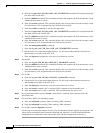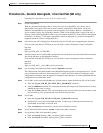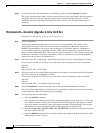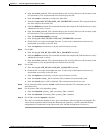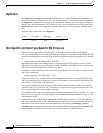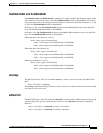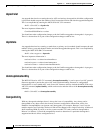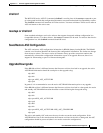
C-46
Cisco MGX 8220 Installation and Configuration
Release 5.0, Part Number 78-6430-03 Rev. D0, November 2003
Appendix C Firmware Upgrade and Downgrade Procedures
Description of Upgrade/Downgrade Terminology
dspadrxlat
Any upgrade that involves resetting the active ASC card and any downgrade in which the configuration
is preserved should compare the number of shelf connections before and after the upgrade/downgrade.
This is accomplished by entering the MGX 8220 ASC CLI command.
shelf.1.<3|4>.ASC.a > dspadrxlat
The most important information is
ConnNumOfValidEntries: <value>
You should not make configuration changes to the shelf while an upgrade or downgrade is in progress.
There is a chance that all or part of the configuration changes could be lost.
dsptotals
Any upgrade that involves resetting a stand-alone or primary service module should compare the total
number of lines, ports and channels before and after the upgrade/downgrade. This is accomplished by
entering the MGX 8220 SM CLI command.
shelf.1.<slot>.<type>.a > dsptotals
The most important information is
total active lines = <value>/<maximumlines>
total active ports = <value>/<maximumports>
total active chans = <value>/<maximumchannels>
You should not make configuration changes to the shelf while an upgrade or downgrade is in progress.
There is a chance that all or part of the configuration changes could be lost.
donotupdatestandby
The MGX 8220 active ASC CLI command, donotupdatestandby, is used as part of an ASC graceful
firmware upgrade to prevent the active ASC card from downloading firmware or configuration
information to a reset standby ASC card. Some ASC firmware releases include the MGX 8220 active
ASC CLI command, updatestandby, which can be used to undo the effects of the donotupdatestandby
command.
shelf.1.<3|4>.ASC.a > donotupdatestandby
Compatibility
With any downgrade technique, there is always the issue of compatibility. Any release can be
downgraded to any other release, but in many instances configuration information will be lost.
Hardware incompatibilities can prevent some downgrades. For example, Releases 2 and 3 service
modules require two Flash chips. Release 4 SMs will be shipped with a single Flash chip. A Release 4
shelf containing BNM-E1 cards or service resource module 3T3 cards cannot be downgraded to
Release 2 or Release 3. Check the compatibility matrix to determine if a particular downgrade is
supported and how it affects configuration loss.



